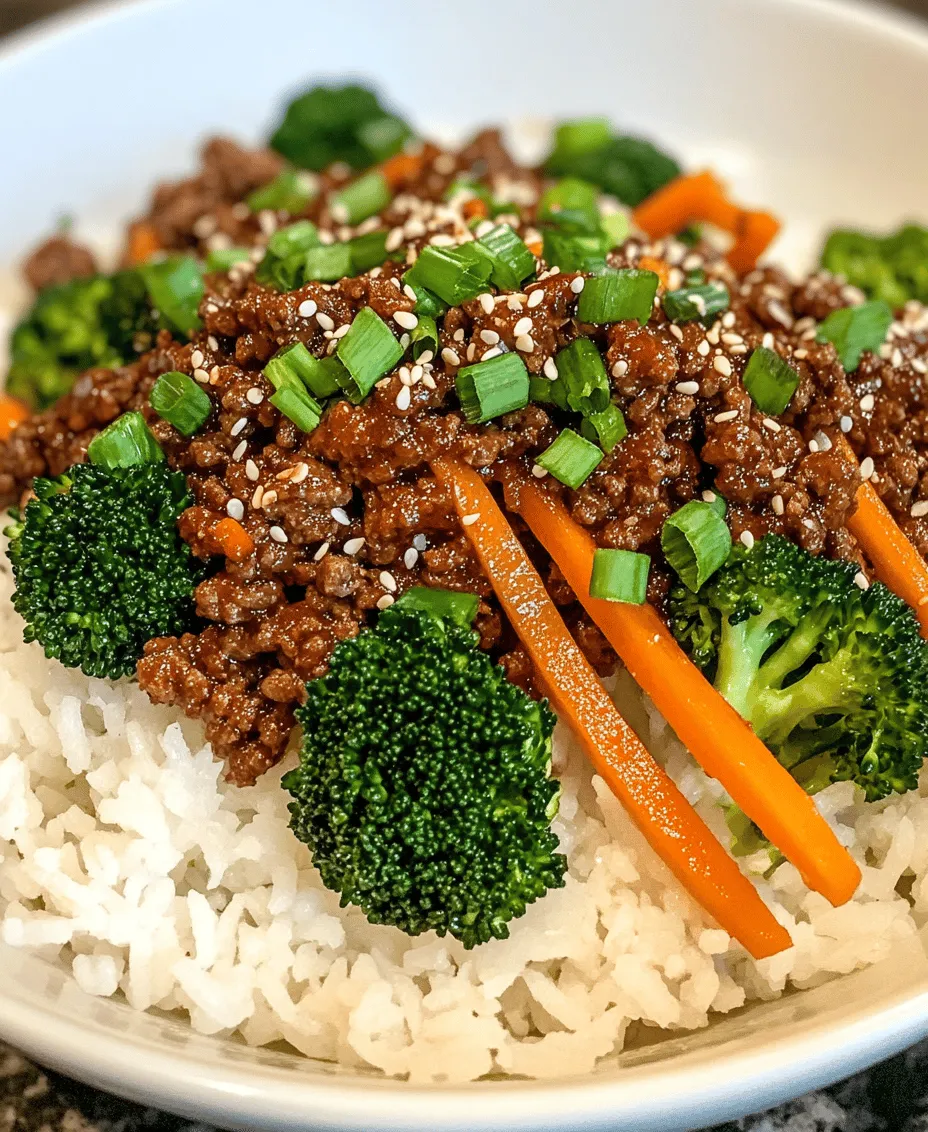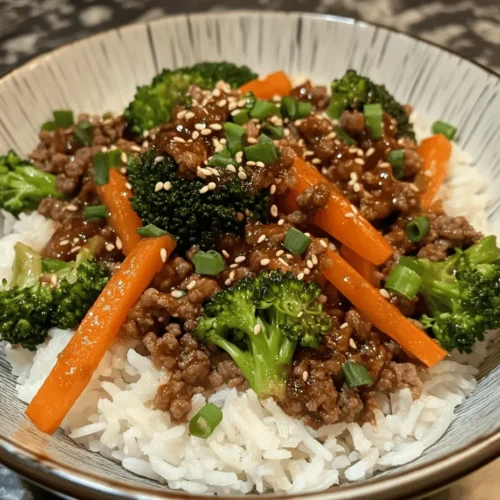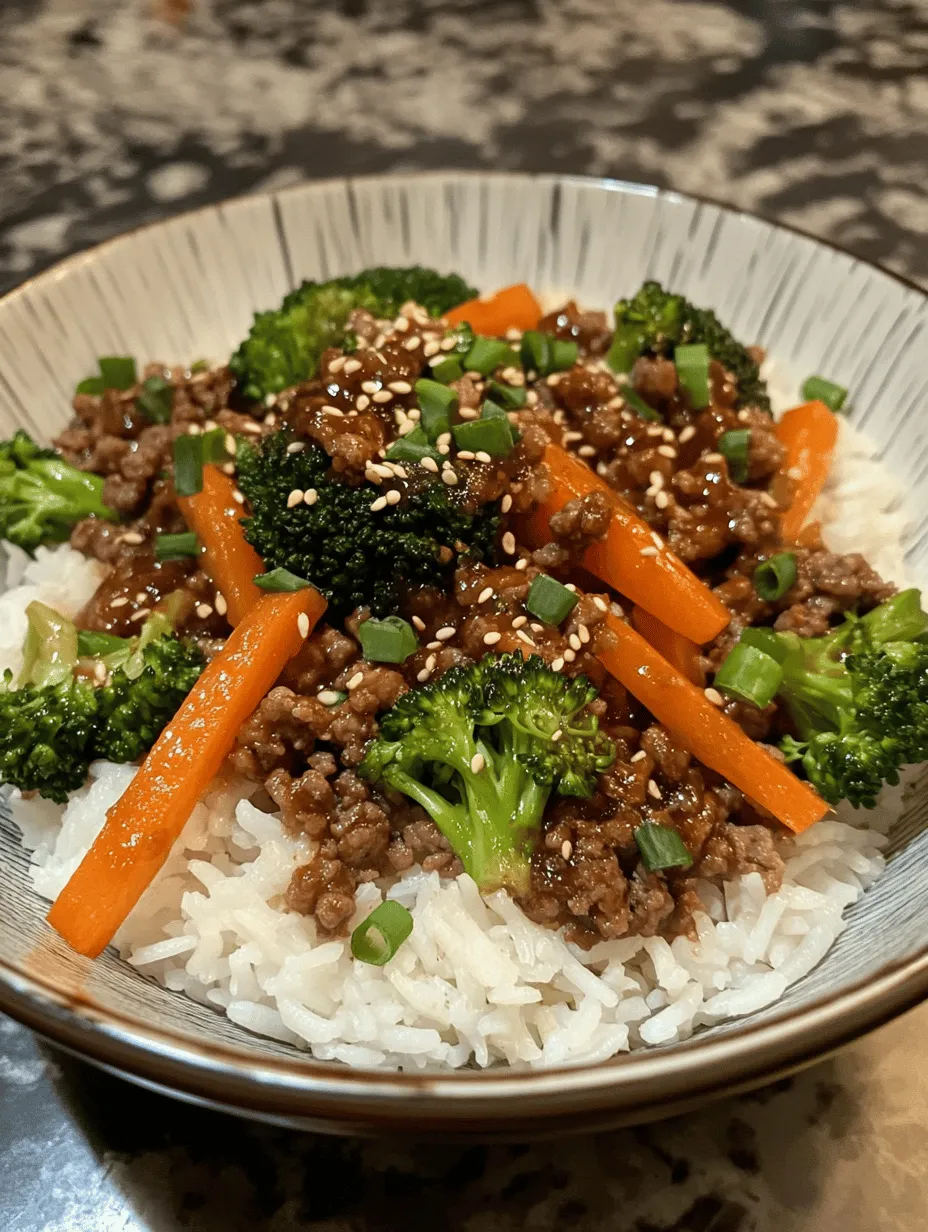Introduction
In the realm of comfort food, the Korean Ground Beef Bowl with Sticky Rice emerges as a delightful fusion of flavors and textures, providing an irresistible blend of savory and sweet notes that tantalize the taste buds. This dish is not just a meal; it’s an experience that transports you straight to the bustling streets of Seoul with every bite. Easy to prepare and quick to cook, it caters perfectly to busy weeknights and casual gatherings alike, making it a favorite among home cooks of all skill levels.
The foundation of the Korean Ground Beef Bowl lies in its vibrant ingredients, each contributing to the overall flavor profile and nutritional value. This dish features succulent ground beef, colorful vegetables, and sticky rice, all held together by a sweet and spicy sauce that elevates it from a simple meal to a culinary delight. As we explore the components, preparation steps, and the cultural significance of this beloved dish, you’ll discover just how accessible and satisfying it can be.
Understanding the Ingredients
To truly appreciate the Korean Ground Beef Bowl, it’s essential to understand each component that contributes to this dish. Let’s dive into the primary ingredients, their roles, and why they are integral to creating an authentic Korean experience.
Ground Beef: The Heart of the Dish
Ground beef serves as the cornerstone of the Korean Ground Beef Bowl. In Korean cuisine, beef is often favored for its rich flavor and tender texture, making it the perfect protein for this dish. When selecting ground beef, consider using a blend with a moderate fat content, around 80/20, as the fat contributes to the meat’s juiciness and enhances the overall flavor. The beef is typically seasoned with a variety of sauces and spices, allowing for a depth of flavor that resonates with Korean culinary traditions.
Essential Sauces and Seasonings
The magic of this dish is largely attributed to its flavorful sauce, which combines several key ingredients:
1. Soy Sauce: This staple in Korean cooking adds depth and umami, balancing the sweetness of the other components.
2. Brown Sugar: The sweetness from brown sugar is essential in creating a harmonious flavor profile, providing a counterbalance to the saltiness of the soy sauce.
3. Gochujang: This fermented Korean chili paste introduces a delightful heat and complexity, making it a crucial element in achieving the authentic taste of this dish.
Each of these sauces plays a vital role in flavor integration, ensuring that the ground beef is both savory and slightly sweet, with just the right amount of heat.
Fresh Vegetables for Color and Nutrition
Incorporating fresh vegetables into the Korean Ground Beef Bowl not only enhances its visual appeal but also adds a plethora of nutrients. Common vegetables used in this dish include:
– Carrots: Shredded or diced, carrots add a subtle sweetness and crunch.
– Green Onions: These provide a fresh, mild onion flavor that brightens the dish.
– Bell Peppers: With their vibrant colors and juicy texture, bell peppers add both sweetness and a satisfying crunch.
Feel free to experiment with other vegetables such as zucchini or broccoli, which can also complement the beef beautifully.
The Role of Sticky Rice in Korean Cuisine
Sticky rice is an essential component of many Korean dishes, serving as a comforting base that absorbs the flavors of the toppings. Unlike regular white rice, sticky rice has a higher starch content, resulting in a glutinous texture that clings together. This characteristic makes it perfect for bowls and stir-fry dishes, as it allows the flavors to meld seamlessly. The combination of sticky rice with the savory ground beef and fresh vegetables creates a satisfying and hearty meal that is both filling and delicious.
Preparation Steps
Creating the perfect Korean Ground Beef Bowl requires a few simple steps that will guide you through the cooking process. Below is a detailed, step-by-step guide to help you achieve the best results.
Creating the Flavorful Sauce
The first step in preparing your Korean Ground Beef Bowl is to create the flavorful sauce that will coat the beef and vegetables. Start by measuring out the following ingredients:
– 1/4 cup of soy sauce
– 2 tablespoons of brown sugar
– 1-2 tablespoons of gochujang (adjust based on your spice preference)
– 1 tablespoon of sesame oil (optional for added richness)
In a small mixing bowl, combine the soy sauce, brown sugar, and gochujang. Whisk until the sugar is well dissolved and the mixture is smooth. If you want an extra layer of flavor, add in the sesame oil. This sauce will be your secret weapon in achieving that authentic Korean taste.
Cooking the Beef to Perfection
Next, it’s time to cook the ground beef. Start by heating a large skillet over medium-high heat. Once hot, add the ground beef directly to the skillet.
Techniques for Browning Ground Beef: To achieve perfect browning, break the ground beef apart using a spatula or wooden spoon. Allow it to sear without stirring for a couple of minutes to develop a rich color. Then, continue to break it up and stir occasionally until fully cooked and no longer pink. This process typically takes about 5-7 minutes.
Once the beef is browned, drain any excess fat if necessary, especially if you prefer a leaner dish. This step is crucial, as it prevents the dish from becoming greasy and allows the flavors of the sauce to shine.
Incorporating Vegetables for Flavor and Texture
Now that your beef is cooked, it’s time to add the fresh vegetables. Begin by adding your chosen vegetables—carrots, green onions, and bell peppers—directly into the skillet with the ground beef.
Tips for Timing and Cooking Vegetables: Add the vegetables in stages based on their cooking times. For example, add the carrots first as they take longer to soften, followed by the bell peppers and green onions, which require less cooking time. Stir everything together and sauté for an additional 3-5 minutes until the vegetables are tender yet still vibrant.
Bringing It All Together
Once your vegetables are cooked to your liking, it’s time to bring the dish together. Pour the prepared sauce over the beef and vegetable mixture in the skillet. Stir well to ensure that everything is evenly coated with the sauce.
The Importance of Simmering for Flavor Integration: Allow the mixture to simmer for a few minutes, letting the flavors meld and intensify. This step is essential for achieving a cohesive taste, as the sauce infuses the beef and vegetables with its savory notes. Keep an eye on the skillet to prevent burning, and give it a gentle stir every now and then.
By following these steps, you will have created a delicious base for your Korean Ground Beef Bowl, ready to be served over sticky rice.
Stay tuned for the next part of this article, where we will explore the best serving suggestions, garnishes, and tips to elevate your Korean Ground Beef Bowl experience. Each bite promises to be a celebration of flavors that showcases the heart of Korean cuisine.

Ideal Serving Sizes and Bowl Presentation
When it comes to serving the Korean Ground Beef Bowl with Sticky Rice, it’s all about balance and aesthetics. A typical serving size for this dish is about 1 cup of sticky rice accompanied by ½ cup of the seasoned ground beef mixture. This portion provides a satisfying meal without overwhelming the palate.
To create an inviting presentation, begin by placing the sticky rice at the center of a shallow bowl. Gently mold the rice into a dome shape for visual appeal. Next, spoon the flavorful ground beef mixture around the rice, allowing it to create a colorful contrast. For that finishing touch, garnish with freshly chopped green onions and a sprinkle of sesame seeds, which not only add flavor but also enhance the dish’s visual appeal. This method of plating not only makes for an Instagram-worthy photo but also helps in separating the flavors for an enjoyable eating experience.
Garnishing with Green Onions and Sesame Seeds
Garnishing is an essential step that elevates the dish’s overall experience. The inclusion of green onions adds a fresh crunch and a pop of color, while sesame seeds contribute a nutty flavor and a delightful texture. To garnish, finely chop a handful of green onions, ensuring you use both the green and white parts for a more vibrant look. After plating your Korean Ground Beef Bowl, sprinkle the chopped green onions generously over the beef and rice.
For sesame seeds, lightly toast them in a dry skillet for a minute or two to enhance their flavor. Once toasted, scatter them over the bowl, allowing their aroma to mingle with the other ingredients. This simple step takes your dish from everyday to extraordinary, making it not only a feast for the stomach but also a feast for the eyes.
Pairing Suggestions: Complementary Dishes and Drinks
To round out your meal, consider pairing the Korean Ground Beef Bowl with complementary dishes that will enhance the overall dining experience. A side of pickled vegetables, known as “banchan” in Korean cuisine, adds a refreshing crunch and acidity that contrasts beautifully with the rich flavors of the beef. Common options include pickled cucumber or radish, which can be prepared ahead of time and served chilled.
In terms of beverages, traditional Korean drinks such as “soju” or “makgeolli” (a type of rice wine) pair well with this dish. If you prefer non-alcoholic options, a refreshing iced barley tea (bori cha) or a simple cucumber-infused water can beautifully cleanse the palate between bites.
Nutritional Insights
Analyzing the Health Benefits of the Korean Ground Beef Bowl
This dish is not only delicious but also offers a range of health benefits. The key ingredients in the Korean Ground Beef Bowl contribute essential nutrients that are beneficial for overall health.
Nutritional Breakdown of Key Ingredients
Ground beef is an excellent source of protein, iron, and vitamin B12. These nutrients are vital for muscle repair, energy production, and maintaining a healthy nervous system. Sticky rice, while being a source of carbohydrates, also provides energy needed for daily activities. The addition of green onions and sesame seeds introduces fiber, vitamins, and healthy fats, making this dish more balanced.
Balancing Macronutrients: Protein, Carbohydrates, and Fats
Each serving of the Korean Ground Beef Bowl is well-balanced, containing a healthy mix of macronutrients. The protein from the ground beef supports muscle growth and repair, while the carbohydrates from the sticky rice offer a quick energy source. Additionally, the healthy fats from sesame seeds help to improve heart health and keep you feeling satiated longer. Overall, this dish provides an ideal combination of macronutrients that can support a healthy lifestyle.
Incorporating More Vegetables for a Healthier Meal
To enhance the nutritional profile of your Korean Ground Beef Bowl, consider incorporating a variety of vegetables. Adding sautéed bell peppers, carrots, or zucchini not only boosts the fiber content but also increases the overall vitamin and mineral intake. A colorful assortment of vegetables not only enriches the dish but also provides a delightful crunch and additional flavor, making it even more satisfying.
Cultural Significance
Exploring the Origins of the Korean Ground Beef Bowl
The Korean Ground Beef Bowl is a dish that embodies the essence of Korean home cooking. Korea’s culinary history is rich and diverse, influenced by geography, climate, and local ingredients. Traditionally, Korean meals are centered around rice, with various side dishes that complement the main course.
A Brief History of Korean Cuisine
Korean cuisine dates back thousands of years, with roots in agricultural practices and seasonal eating. The use of fermented foods, such as kimchi, is a hallmark of this cuisine, as it reflects the importance of preserving food in a country with harsh winters. Over time, Korea has incorporated various cooking techniques and flavors, leading to the vibrant food culture we see today.
The Role of Beef in Korean Dishes
Beef holds a special place in Korean culinary tradition. Known for its rich flavor and tenderness, it is often showcased in dishes such as bulgogi (marinated beef) and galbi (short ribs). The Korean Ground Beef Bowl highlights this beloved ingredient, making it a go-to choice for many families seeking a comforting and hearty meal.
Understanding the Influence of Gochujang and Other Ingredients
Gochujang, a fermented chili paste, is a staple in many Korean dishes, including our ground beef bowl. Its unique blend of spicy, sweet, and savory flavors adds depth and complexity to the dish. The incorporation of garlic, ginger, and soy sauce complements the gochujang, creating a harmonious balance that is characteristic of Korean flavors.
Variations and Customizations
Making the Dish Your Own
One of the best aspects of the Korean Ground Beef Bowl is its versatility. You can easily adapt the recipe to suit your personal tastes or dietary preferences.
Alternative Proteins: Chicken, Tofu, or Pork
If you’d like to substitute the ground beef, consider using ground chicken or turkey for a leaner option. For a vegetarian or vegan twist, crumbled tofu or tempeh can be seasoned in the same way as the beef, absorbing all the wonderful flavors. Alternatively, ground pork is another delicious option that adds a different richness to the dish.
Vegetable Substitutions for Seasonal Freshness
Seasonal vegetables can also be swapped in to keep the dish fresh and exciting. In the spring, consider adding asparagus or snap peas, while in the fall, roasted sweet potatoes or butternut squash can provide a warming comfort. The versatility of this dish allows you to enjoy it year-round with whatever produce is in season.
Adjusting Spice Levels for Personal Preference
For those who prefer milder flavors, you can reduce the amount of gochujang or opt for a milder chili paste. Conversely, if you enjoy a spicier kick, feel free to add extra gochujang or even some fresh sliced chili peppers to the mix. This customization allows everyone to enjoy the dish according to their spice tolerance.
Conclusion
The Korean Ground Beef Bowl with Sticky Rice is a versatile and satisfying dish that encapsulates the essence of Korean home cooking. With its rich flavors, vibrant colors, and nourishing ingredients, it not only fills the stomach but also warms the heart. Whether enjoyed as a quick weeknight meal or a comforting feast with family and friends, this recipe is sure to become a favorite in your culinary repertoire. Embrace the joy of cooking and savor each bite of this delectable dish. By implementing these serving suggestions, nutritional insights, cultural context, and customization ideas, you can create a meal that is not only delicious but also resonant with the rich history and flavors of Korean cuisine.



